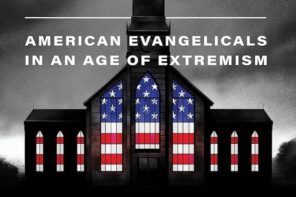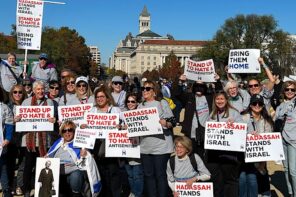I was David Barton once. Having had a conversion to evangelical Protestantism in the 1980s, I became convinced in the early 1990s that “liberal secularism” was destroying the nation and its educational system. I determined to use history to fight back. Examining primary sources from the founding of the United States, I set out to prove that America was built upon “Judeo-Christian values.”
I combed through colonial law and early state constitutions. I read as many speeches and letters as I could from George Washington, Thomas Jefferson, and John Adams. It was a tall historical task, especially since I was a teenager living in suburban New Jersey. My research and writing were sandwiched between basketball practices and flirting with girls (both of which I did with great earnestness and equally great ineffectiveness). Years later, my interest in religious history and justice (I really believed then that evangelicals were an oppressed minority) brought me to race, civil rights, and liberal causes. I thought I was unique; it turns out I was wrong.
Kevin Schultz’s new book, Tri-Faith America: How Catholics and Jews Held Postwar America to Its Protestant Promise, explains my story and so much more. This tremendous study examines how the belief that Protestantism, Catholicism, and Judaism defined the United States defeated the nativist vision of America as a “Christian nation”; how the concept of “Judeo-Christian values” were created to express the tri-faith belief; how tri-faith became standard operating procedure during World War II as the nation battled European totalitarianism and Nazi genocide; how it created new struggles in America’s suburbs, fraternal organizations, schools, and courts; and how it created a rhetoric for both the Civil Rights Movement and the rise of the new religious right. Through it all, Schultz brilliantly shows that between the labor-capital divide of the 1930s and the racial divide of the 1960s was an ideological contest over the religious composition of the nation.
The first half of Tri-Faith America focuses on the early-twentieth-century battle between those who considered the United States a “Christian nation” and those who pushed for the tri-faith concept. The forces for unity and exclusion were numerous and powerful. A resurgent Klan was led by men like Hiram Wesley Evans who wanted the nation to be a “Native, white, Protestant supremacy.” Antisemitic and anti-Catholic groups were on the rise. When Franklin Roosevelt was elected president, there were only five senators who were Catholic (none were Jewish), and two Catholic governors. In 1942, Roosevelt admitted that the United States was a “Protestant Country” and lamented that “the Catholics and Jews are here under sufferance.”
A cohort of Protestants, Catholics, and Jews altered the nation. First in the Social Gospel movement, the three groups ran into one another during charitable crusades. Then in the mid-1920s, a new organization calling itself the National Conference of Christians and Jews (NCCJ) emerged to push for interreligious goodwill efforts. The NCCJ are the flawed heroes of Schultz’s tri-faith world.
Led by Everett Clincy, the NCCJ was the engine of tri-faith America. They sent “Tolerance Trios” throughout the land where a minister, priest, and rabbi would lead roundtable discussions about religious bigotry and friendship. Then during WWII, the NCCJ hit the nation and its military instillations hard. They spoke directly to nine million Americans and distributed a tri-faith “prayer card” that had a prayer from each faith. They also deployed widely the concept of “Judeo-Christian” values, a new rhetorical creation from the late nineteenth century that linked religious families that had long been at war. “Judeo-Christian values” were aligned with the nation to mean freedom of speech, thought, and religion. In essence, “Judeo-Christianity” was understood to be an underpinning of democracy.
During WWII and the early Cold War era, “tri-faith America” became the standard. Chaplains identified as Protestant, Catholic, or Jew. Dog tags did the same. And the different faiths used the same chapels for worship. One fascinating comic book titled Three Pals featured three high school football players—a Protestant, a Catholic, and a Jew—going off to war and dying in the same spirit.
Then Schultz shows how, in the early Cold War era, tri-faith America helped the nation stand against the monster of atheistic Communism. Although less interested in “Judeo-Christian” values as a theological concept and more invested in its civic morality, groups like the Advertising Council championed Protestant, Catholic, and Jewish brotherhood for the good of the nation. By the early 1950s, faith in tri-faith abounded. President Dwight Eisenhower signed into law the National Day of Prayer, while Congress put “God” on the currency and in the national motto.
Yet just as the tri-faith idea tied Americans together, it created new arenas of stress. At his very best, Schultz demonstrates how, during the seemingly conformist 1950s, religious communalism and conflict proliferated. When Catholics, Jews, and Protestants moved to new suburbs, for instance, they didn’t merge into some undifferentiated blandness. While films like Invasion of the Body Snatchers presented suburbanites as so similar that aliens could invade their bodies without anyone even knowing, the reality on the ground was religious communalism and contestation. Protestants, Catholics, and Jews may have greeted one another cordially at the supermarket or a PTA meeting, but they often formed different organizations, spent their social time separately, dated distinctly, and reinforced the idea of communalism as a positive force.
These struggles moved beyond the suburbs to college campuses. Fraternities had long been built on exclusion, and Protestant whiteness was often a key component. With greater numbers of Jews and Catholics on campus in the 1940s and 1950s, one fraternity even changed its charter to limit members to “Caucasian Christians.” Jews and Catholics challenged these discriminatory practices, but also defended their own autonomous organizations. As Schultz so nicely shows, fraternity struggles highlighted the problems of enforced integration. Jewish and Catholic students wanted the right to be a part of any and all fraternities, but they also wanted the rights to maintain their own exclusive organizations and protect their religious identities.
Time and again, religious differences led to legal battles and social debate. Schools became particular sites of religious disagreement, and Protestant, Catholic, and Jewish actions generated the battery of Supreme Court cases over religion that led to the “second disestablishment” of religion. By the end of the 1950s, religious dissension was so boisterous that efforts to put a question about religion on the United States census fell apart. In the legal and social struggles, Catholics and Jews had effectively helped create a new right in the United States: the right to religious privacy.
Concluding his work, Schultz demonstrates how the tri-faith concept softened the ground for civil rights activism and how the “Judeo-Christian” notion became so powerful that even enemies of religious pluralism used it. During the 1950s and 1960s, civil rights activists tapped into the language of tri-faith America. Martin Luther King Jr. and his cohort could be heard singing the praises of “Judeo-Christian” values and challenging Protestants, Catholics, and Jews to work together for racial justice. Moreover, many of the civil rights lawsuits and ideological battles over individual and group rights had been played out in religious circles. When Lyndon Johnson wanted support for civil rights legislation, he often brought in Protestant, Catholic, and Jewish leaders.
Tri-faith subsequently revealed how powerful it was when a new conservative coalition arose trying to win back America for Jesus deploying the language of “Judeo-Christianity.” When Jerry Falwell and Billy James Hargis pushed for a renewal of “Christian America,” they did so with the rhetoric and tools that had previously pushed against “Christian America.” In the early twentieth century, it was conservative evangelicals who were demanding that the government provide support for private religious schools and who were courting conservative Catholics and Jews for political aid.
One of the most impressive features of Schultz’s study is his use of sources. For the first half of the book, he relies primarily on the archive of the National Conference of Christians and Jews. This is a fairly standard analysis of letters, reports, and plans, while the middle and final portions of the book rely on a plethora of other sources. Schultz investigates movies and comic books; analyzes court cases and political speeches; and, quite impressively, he grabs the data of sociologists from the time and puts them together to present tri-faith America in all of its splendor, chaos, and complexity. Schultz takes findings from books we’re familiar with, such as Will Herberg’s Protestant-Catholic-Jew and Herbert Glans’ The Levittowners, in addition to lesser-known works, to build a new image of midcentury America. The effect is impressive. While Herberg and others thought they had identified uniformity, Schultz shows debate and discord.
Another fascinating element of Schultz’s work is an irony he discovers along the way. The drive to embrace tri-faith America, it turns out, helped institutionalize and legislate a trend toward secularization in American life. In the process of vying for places and protections in the United States, Catholics and Jews helped make it possible for the legal revolution of the second disestablishment and for Barack Obama to say in 2009 that the United States was not a “Christian nation or a Jewish nation or a Muslim nation. We consider ourselves a nation of citizens who are bound by ideals and a set of values.”
Tri-Faith America joins a list of new books on religion and American society at midcentury that reformulate the entire era. Whether it was Matthew Avery Sutton showing how Fundamentalist Christian conservatism and nationalism was made, in part, through the technological and cultural innovations of the former Canadian-faith-healer and career divorcée Aimee Semple McPherson just outside of Hollywood, or Darren Dochuk detailing how the Bible Belt moved to the Southern California Sun Belt during the Great Depression and transforming evangelicalism into a powerhouse for creative conservatism, or the recent work of David Chappell, Paul Harvey, and Barbara Diane Savage linking religious worldviews to changes in civil rights politics, our entire understanding of the era has been transformed in the last decade. We have Schultz to thank for including a more robust examination of interactions between and among Protestants, Catholics, and Jews in the sagas of the age.
Schultz’s study leads to a series of questions that, we hope, he and other scholars will address. For instance, did the tri-faith concept lay the foundation for Americans to view Islam as “evil” or “primitive” because it was not associated with democracy? Since tri-faith tied Protestantism, Catholicism, and Judaism to democracy and viewed democracy as inherently good, did it inhibit pluralism in the U.S.? What work did gender do in this movement? The actors in Schultz’s book are almost all male and he rarely investigates the gendered elements of the rhetoric. For instance, if tri-faith America were built upon the notion of the “brotherhood of man” and the “Fatherhood of God,” how would feminist theologians like Mary Daly read its decidedly patriarchal tone? A gendered analysis of tri-faith America may show that feminist and womanist theologians had even more to combat than racism, sexism, and classism. They had to confront the networked patriarchal web of faith traditions, faith-in-faith, and iterations of American nationalism.
Without doubt, Tri-Faith America will have religious studies scholars debating Schultz’s approach to what “religion” is and it will have historians debating exactly how potent a problem tri-faith America really was. But for me, Tri-Faith America helped explain how and why at seventeen I used the language of “Judeo-Christianity” for conservative evangelical ends, while remaining intellectually and morally open to civil rights and liberal crusades.




